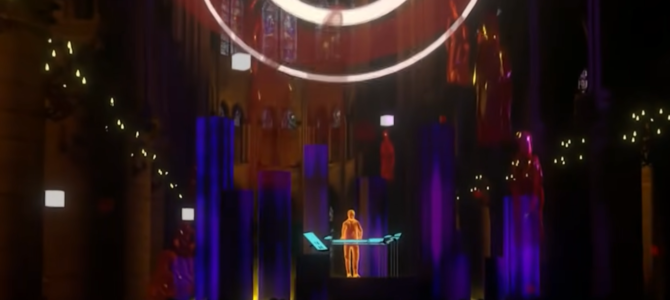
Pandemic lockdowns crushed the concert industry, but things are finally starting to move again. Many of us are optimistic that dense crowds might gather regularly by mid-autumn. The process is already starting in red states. Once everybody who’s anybody “takes the jab,” mass events should spread slowly across the country.
All over the world, people are dying for another taste of what Émile Durkheim called “collective effervescence”: the intense thrill we get from a mass gathering with a common purpose. You’ll find it at rock shows, political rallies, and religious revivals.
Durkheim saw this act as the basis for shared religious experience and group solidarity. We need each other’s smiling faces, synchronic movements, and even body odors. It’s part of the natural human need for community.
Following the Leaders at SXSW
But what will entertainment look like under the mindless restrictions that hypocritical elites are trying to sell as the “New Normal”? Search no farther than South by Southwest. Every spring, the event attracts a quarter of a million trend-chasers to Texas. Convened in downtown Austin, SXSW is to the concert industry what the World Economic Forum is to corporate globalism.
Much like the leaders of this year’s World Economic Forum, the big thinkers at last weekend’s SXSW called for a “Great Reset” in entertainment. If their overarching vision comes to pass, future “live” concerts will be immersive digital environments complete with augmented reality—basically, rave culture writ large. The dream of the ‘90s is alive in Austin.
SXSW visionaries fantasize about the “embodiment of avatars” in mixed reality, critical race theory for the music industry, and how to capitalize on the expanding “Metaverse“—that digital realm “driven by a new generation growing up online and global platforms paving a new way for people to be together, even when they can’t in person.” Other sessions had snappy titles like “Immersive Retail: Connected Shopping in a New Era,” “Beyond the Gender Binary,” and “Gene Editing: The Biotech Revolution of our Times.”
Industry experts answered heavy questions like “Can VR Create Real Change?” (as in socio-political change), and “Can 5G Transform the Live Music Experience?” Without paying $400 to find out, I assume the answer to both is “Yes—isn’t it great?” If the wildest fantasies of tech innovators come true, they’ll become so all-encompassing we’ll never wake up from them.
Welcome to the Other Side
For a year now, almost every live show has been held in a virtual format. For the most part, the experience is super-lame, like a long Zoom call where you never get to talk. Despite their best efforts, set designers and VR programmers haven’t synthesized Durkheim’s collective effervescence. But they’re trying.
One of the big showcases at SXSW was “Welcome to the Other Side,” a virtual DJ set performed in a digital rendition of Paris’ Notre Dame cathedral. This is an ideal arrangement in a society where the cathedral isn’t a practical concert venue. Unless your Oculus headset explodes on your face, the venue is basically fireproof.
Because there are no physical limitations in virtual reality, the set design was superb. The animated star, Jean-Michel Jarre, was flanked by morphing 3D video walls and surrounded by loops of curved light beams. In the tradition of DJs twisting knobs vigorously—pretending to do something impressive while pre-recorded music throbs on the sound system—Jarre’s avatar pretended to control green lasers.
Out in the real world, millions of people danced around their living rooms, their eyes blanked out by VR head-sets, floorboards creaking quietly like some worldwide silent disco. Whether they like it or not, any forward-looking artist will move in this direction. From video games to romantic encounters, stakeholders are hyping VR and other immersive technologies as a necessary step in human evolution.
“Virtual reality is to the performing arts today what cinema was to the theatre in its early days,” Jarre prophesies with a French accent thicker than TV static. “I believe that VR will become tomorrow, a mode of expression in its own right.”
All Tomorrow’s Parties
The Notre Dame simulation was impressive. Like clever magicians, its producers managed to desecrate one of Christendom’s holiest sites without ever stepping foot inside. But what if they could create their own techno-pagan temples from scratch?
For 16 years, the Belgian electronic music festival Tomorrowland has done exactly that. Its sprawling structures are legendary. The main stage featured a massive sun-god one year, an elaborate cosmic tree in another. Each show pushed stagecraft to its limits.
Then last year, COVID-19 restrictions forced the communal event online, along with everything else in the world. In response, Tomorrowland’s promoters created a vast virtual space, powered by 3-D technology. Pre-recorded DJs appeared onstage via green screen, pretending to do something awesome while pre-recorded tracks played on their turntables.
The stages for Tomorrowland’s New Year’s Eve show were among the most elaborate I’ve ever seen. Set designers were finally able to draw fans into their vivid dream without the constraints of Newtonian physics.
As a tour rigger in my professional life (and a raver in my ill-spent youth), I’m always fascinated by concert technology. It’s thrilling to hang 50 tons of intricate, dynamic gear in the air, then watch it come alive above performers and crowds. One major challenge is figuring out how to bring the set designer’s vision into the physical world—using heavy equipment—while keeping everyone safe.
Virtual productions circumvent that problem. With ornery riggers on lockdown, Tomorrowland techs managed to erect their exquisite structures with no one there to say, “No way! It’ll collapse under its own weight!” What designer could resist this power?
The New Year’s Even show boasted enormous truss rings suspended by magic, firing lasers on the virtual audience like UFO probes. From behind glowing screens, “attendees” watched a huge psychedelic seahorse swimming above a mob of soulless avatars. Disembodied viewers chased luminous energy balls through the waving branches of the “Tree of Melodia,” enclosed by stained-glass cathedral walls.
Such possibilities can only be unlocked in a virtual environment. For artists with a serious God-complex, it’s a great time to be alive.
Our Techno-Pagan Future
There’s a genuine religious zeal at the heart of rave culture, reflected in the wider entertainment-industrial complex. For instance, Tomorrowland’s NYE after-movie closes with this cringe-inducing doxology:
Great people of tomorrow… When life is darkest and sadness reigns, the Tree of Melodia uses its music to heal. When sound moves through Her branches, the soul of the Tree is speaking. … Live today. Love tomorrow. Unite forever.
It’s hard to “unite forever” while sitting alone with VR goggles over your eyes, but with sufficient investment, who knows? If relentless progress continues, your withered soul might be healed by some make-believe tree on the Internet.
Doubters may sneer, but this mystical quest has a history of mass appeal. It was already old news when the prescient Douglas Rushkoff published his 1994 classic, “Cyberia: Life in the Trenches of Hyperspace.”
“Cyberia is about…a moment when anything seemed possible,” Rushkoff observed. “An entire subculture—like a kid at a rave trying virtual reality for the first time—saw the wild potentials of marrying the latest computer technologies with the most intimately held dreams and the most ancient spiritual truths.”
Rushkoff finished the book in 1992, but his publishers worried “electronic mail” and “the Internet” were just passing fads, too far out to stay relevant. Years later, the same skeptics are living life through this new thing called a smartphone.
The real irony is how many one-time optimists now despise this controlled techno-topia. Deep down, we prefer the ancient rite of gathering together in close contact, with no immersive gadgets or hygienic barriers. We want chance encounters and pre-smartphone serendipity. We want each other’s visceral presence: real communion.
We want organic life in the forefront, with advanced tech as an afterthought. Unfortunately, that’s not the future being planned for us.









